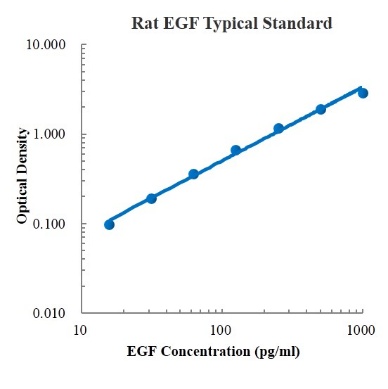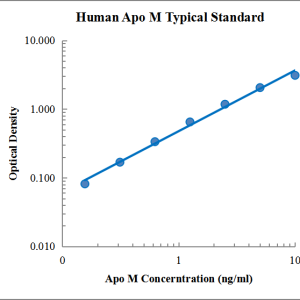Rat EGF ELISA Kit
$299.00 – $419.00
ELISA Kit Detail Information
| Related Target | |
|---|---|
| Species | rat |
| Sample Type | Serum, plasma, cell culture supernatant, and other biological samples |
| Sample Volume | 20 μL |
| Sensitivity | 0.33 pg/mL |
| Array Range | 15.63 pg/mL – 1000 pg/mL |
| Assay Time | 3.5 h |
| Recovery | 94% – 110% |
| Average Recovery | 101% |
| Intra Precision | 1.7% – 5% |
| Inter Precision | 5.9% – 7.5% |
| Plate | Detachable 96-well plate |
| Storage | If the reagent kit is unopened, it should be stored at 4℃. However, if it has been opened, the standard solution should be stored at -20℃, while the other components should be stored at 4℃. |
| Delivery | 4℃ blue ice transportation |
| Components | 96-well polystyrene enzyme-linked immunosorbent assay (ELISA) plate coated with anti-EGF monoclonal antibody Rat EGF freeze-dried standard EGF detect Antibody Standard Diluent HRP-labeled streptavidin Signal enhancer concentrate Signal enhancer diluent Assay Buffer(10×) Substrate TMB Stop Solution Washing Buffer(20×) Sealing Film |
| Assay Principle | This kit utilizes the double antibody sandwich enzyme-linked immunosorbent assay (ELISA) detection technique.Specific anti-rat EGF antibodies are precoated on a high-affinity ELISA plate. Standard samples, test samples, and biotinylated detection antibodies are added to the wells of the ELISA plate. After incubation, EGF present in the samples binds to the solid-phase antibodies and the detection antibodies. After washing to remove unbound substances, streptavidin-HRP labeled with horseradish peroxidase is added. After washing, a colorimetric substrate, TMB, is added and the plate is incubated in the dark for color development. The intensity of the color reaction is directly proportional to the concentration of EGF in the samples.A stop solution is added to terminate the reaction, and the absorbance value is measured at a wavelength of 450 nm (with a reference wavelength range of 570-630 nm). |
Related Targets
EGF
EGF Target Infomation Overview
- Target Symbol: EGF, epidermal growth factor
- Alias Names: Pro-epidermal growth factor; epidermal growth factor (beta-urogastrone)
EGF, epidermal growth factor Target Infomation by Species
- Human
- Mouse
- Rat
Human EGF Target Information
- Target Symbol: EGF, epidermal growth factor
- Alias:
- beta-urogastrone
- HOMG4
- pro-epidermal growth factor
- URG
- NCBI_Gene: 1950
- UniProtKB: P01133
Human EGF Predicted Functions
Enables growth factor activity and guanyl-nucleotide exchange factor activity. Involved in several processes, including ERK1 and ERK2 cascade; positive regulation of macromolecule metabolic process; and positive regulation of signal transduction. Acts upstream of or within positive regulation of cell population proliferation. Located in extracellular exosome. Implicated in several diseases, including Zollinger-Ellison syndrome; hepatobiliary system cancer (multiple); high grade glioma (multiple); lung non-small cell carcinoma (multiple); and primary hypomagnesemia (multiple). Biomarker of several diseases, including acute kidney failure; lupus nephritis; neurodegenerative disease (multiple); pancreatic cancer (multiple); and pancreatitis.
Mouse Egf Target Information
- Target Symbol: Egf, epidermal growth factor
- Alias:
- AI790464
- expressed sequence AI790464
- NCBI_Gene: 13645
Mouse Egf Predicted Functions
Enables epidermal growth factor receptor binding activity. Involved in several processes, including negative regulation of cholesterol efflux; positive regulation of ubiquitin-dependent protein catabolic process; and regulation of receptor signaling pathway via JAK-STAT. Acts upstream of or within several processes, including mammary gland alveolus development; positive regulation of cerebellar granule cell precursor proliferation; and positive regulation of protein tyrosine kinase activity. Located in extracellular space and plasma membrane. Is expressed in several structures, including 1st branchial arch; alimentary system; brain; genitourinary system; and liver and biliary system. Human ortholog(s) of this gene implicated in several diseases, including Zollinger-Ellison syndrome; hepatobiliary system cancer (multiple); high grade glioma (multiple); lung non-small cell carcinoma (multiple); and primary hypomagnesemia (multiple). Orthologous to human EGF (epidermal growth factor).
Rat Egf Target Information
- Target Symbol: Egf, epidermal growth factor
- Alias:
- LOC103691699
- pro-epidermal growth factor
- uncharacterized LOC103691699
- NCBI_Gene: 25313
Rat Egf Predicted Functions
Enables epidermal growth factor receptor binding activity. Involved in several processes, including positive regulation of DNA biosynthetic process; positive regulation of ERK1 and ERK2 cascade; and positive regulation of fibroblast proliferation. Acts upstream of or within regulation of protein transport. Located in extracellular space. Used to study perinatal necrotizing enterocolitis. Biomarker of acute kidney failure. Human ortholog(s) of this gene implicated in several diseases, including Zollinger-Ellison syndrome; hepatobiliary system cancer (multiple); high grade glioma (multiple); lung non-small cell carcinoma (multiple); and primary hypomagnesemia (multiple). Orthologous to human EGF (epidermal growth factor).














Reviews
There are no reviews yet.